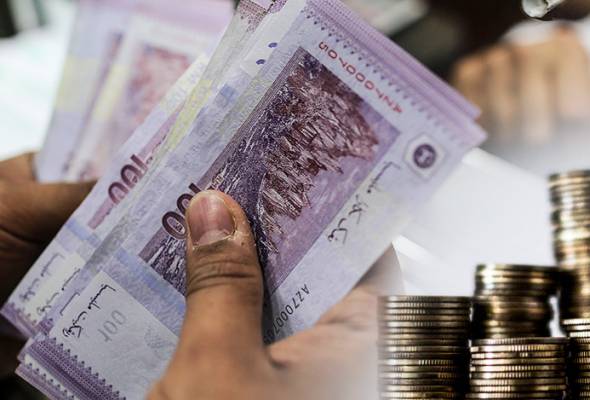
Published in BusinessToday & AstroAwani, image by AstroAwani.
Under downward pressure for some time already, the ringgit has been trading between RM4.50 to RM4.55 lately.
The ringgit’s depreciation is a price to pay for allowing our currency to float.
The “flipside” is the maintenance of our monetary sovereignty – notwithstanding the existence of fixed or pegged currencies – linked as it is to lex monetae which simply means that the issuance and denomination and use of a currency is governed by its (in our case, i.e., Malaysian) national laws.
In other words, monetary sovereignty is driven by legal sovereignty and legal sovereignty can be expressed by monetary sovereignty.
Taking a step further, a fiat currency, i.e., which isn’t (legally/freely) convertible into gold (on demand) has its acceptance solely by sheer governmental decree (fiat). The coercive force behind and underlying the use of a currency can be principally seen in the taxation system – “taxes drive the currency”.
The imposition of a currency has customarily (as proven by history and archaeology) been enforced by the levy of taxes, including by colonial powers. If we were to take things even further back in time, we would see that money is essentially credit (even under conditions of money as commodity, e.g., gold standard), i.e., an “I-O-U”.
In other words, to fully make sense of money, the chain of causation (both in conceptualisation as well as implementation) has to be traced back all the way – from the user – to the issuer itself.
Which – in most circumstances – is none other than the State.
Credit can, therefore, take any form and includes anything which doesn’t have an inherent value like tally sticks (e.g., as made from animal bones) and shells. The late renowned anthropologist David Graeber’s Debt: The First 5000 Years provides a vivid account of the evolution of the concept of credit throughout human history whereby the financial is underpinned by the legal. And, by extension, the primary role of money functioning as unit of account.
What all this means is that money is a creation of the State – right from the beginning.
Needly to say, the concept of money as credit is what anticipates current developments in e-cash, for example.
Such an analysis has critical bearing on the understanding of currency understood as the icon of a national monetary system.
It offers and provides a healthy balance between allowing the currency to float (i.e., subject to market forces) and deploying the levers of the State to conserve or preserve its value.
EMIR Research did suggest, simply as a matter of policy exploration, the pegging of the ringgit on a timely, targeted and temporary manner (“To peg or not?”, 30 December 2019) at one time (i.e., set in the context of the tenure of the seventh Prime Minister who was famous for pegging the ringgit and defeated the speculators during the Asian Financial Crisis). But at the same time, we also hinted that this is wasn’t a priority at all.
In fact, EMIR Research agrees wholeheartedly with Bank Negara on the necessity not to do so.
For one, this would compromise our monetary sovereignty as Bank Negara would be expected to match or “mirror”/“shadow” or approximate its overnight policy rate (OPR) with the federal funds rate (FFR).
The latter (“mirroring”) is employed as in the case of the Hong Kong Monetary Authority (HKMA) at either 50 basis points above the lower end of the prevailing target range for the FFR or the average of the five-day moving averages of the overnight and one-month Hong Kong Interbank Offered Rates (HIBORs), whichever is the higher.
Again, this shows that even where it’s said that Hong Kong’s interest rates are subject to market forces, this also needs to be taken with a pinch of salt.
The State in the form of the HKMA – being the centrepiece of macroeconomic analysis – does affect commercial banks’ lending rates (see e.g., “Hong Kong’s banks raise prime rates after city’s funding cost soars to 16-year high as US Fed leaves the door open for more inflation-busting moves”, South China Morning Post, 27 July 2023).
Even the Monetary Authority of Singapore (MAS), functioning like a semi-currency board (i.e., assuming some of the characteristics inherent in the HKMA), is the (sole) administrator of the island republic’s interbank market, i.e., the Singapore Overnight Rate Average (SORA).
Otherwise, pegging whilst maintaining monetary autonomy would require Malaysia to re-impose and enhance/widen capital controls.
In other words, expanding and deepening the pre-existing rules/regulations in terms of hedging, thresholds, licensed onshore and offshore forex providers, conversion limits, etc. under an amended Exchange Control Act, 1953 and a de-liberalised foreign exchange policy (FEP)/foreign exchange administration (FEA).
The critical issue is, therefore, set within the context or framework whereby our currency remains non-internationalised (i.e., non-tradable) for speculative purposes. In other words, the non-convertibility of the ringgit into the USD applies to anything in excess of a certain amount in the forex swap market.
Since de-pegging in 2005, the ringgit is now under a so-called “managed float” system – whereby Bank Negara only intervenes to smoothen out extreme fluctuations or volatilities in the short- (spot leg) as well as to occasionally influence forex movements in the medium-term (forward leg).
This is unlike MAS which typically has excess official forex reserves (OFR) above and beyond what’s needed (i.e., between 65% to 75% of GDP) to manage the SGD under its own distinct “managed float” system of the triple policy band (slope, width, level).
Whilst (hard) pegging isn’t a sustainable move for Malaysia in the final analysis, simulated (“artificial”) pegging should be explored – in a timely, targeted and temporary manner in tandem with further liberalisation of capital controls (i.e., for the capital account) and shape market expectations should the ringgit be fully internationalised.
That is to say, the State intervening this time by deploying its regulatory firepower in order to tilt the “rules of the game” in the market in its favour by setting and determining the forex rate on one side of the currency pair (buying/selling). This parallels the deployment of the central bank’s monetary firepower in setting and controlling the yield curves along the entire spectrum of the term maturity structure (short-term, long-term bonds).
For example, the Bank of Japan (BOJ) has (with its unlimited “bond-buying power”) consistently beat down the short-sellers (speculators) who thought that they could force the yield curve control (YCC) policy to be abandoned.
The role of the State via the central bank here is to guide market participants towards a desired level of forex rate – weakly analogous to Bank Negara’s short-term monetary operations for liquidity management in the inter-bank market (Kuala Lumpur Inter-Bank Offered Rate/KLIBOR) whereby intervention is to ensure that the market rates align with the OPR.
With this in mind, the policy recommendations are as follows:
- Liberalising the convertibility of the RM – onshore market (short- to medium-term)
Allow for onshore access to the RM for forex swap by non-resident entities (individual, institutional) but the conversion back to the RM must be fixed beforehand – e.g., at RM4.15 (i.e., selling “quote” of onshore appointed/licensed banks) or a “convertibility zone” which, e.g., straddles between RM4.15 to RM4.25 – if higher than the current forex rate.
The underlying purpose of this specific arrangement is to allow for the provisional internationalisation of the ringgit but under controlled conditions to facilitate demand for the currency whilst simultaneously regulating speculative activities in our favour – that is, “guiding” market participants to adopt a long position (rather than a short one).
- Liberalising the convertibility of the RM – offshore market (short- to medium-term)
Bank Negara to work with MAS to transform the non-deliverable forwards (NDF) market – boosting ringgit supply and liquidity by allowing for delivery and settlement in the ringgit for derivative contracts (futures, options) outside of Malaysia.
Again, the conversion back to the RM must be fixed beforehand, e.g., at RM4.15 (if higher than the current forex rate) or initial rate of borrowing (i.e., higher than the current forex rate) as the selling “quote” of offshore appointed/licensed banks.
The provision of ringgit liquidity shall be made on a “request on demand” – so that the supply of currency will be transferred from appointed/licensed onshore Malaysian banks which in turn will borrow from Bank Negara.
In effect, the onshore and offshore (Singaporean) appointed/licensed will engage in currency swaps (i.e., which include interest rate swaps).
A breach of the undertaking will expose both the Malaysian and Singaporean banks (appointed overseas offices/AOOs) to criminal and civil liabilities and proceedings under Malaysian law.
- Issuance of special bonds targeted at Chinese capital (short- to medium-term)
We should aim to attract proceeds from the off-loading and downsizing of Treasury holdings (securities/savings account with the Federal Reserve) by China to be re-invested (whereby its dollar holdings under the reserves/checking account with the Federal Reserve is exchanged for the ringgit) and wired directly into (domestic) Authorised Depository Institution (ADI) accounts for purchase of Malaysian Government Securities (MGS) – with the forex rate of the purchase at, e.g., RM4.15 (if higher than the original forex rate, i.e., at the time when settlement/payment was made) and payout (conversion back into USD) is automatically subject to the prevailing forex rate.
If appreciation of the ringgit has occurred then, the forex rate will be a certain basis points lower to reflect the discount of the par/face value of the bonds.
These MGS holdings shall be non-tradable in the secondary markets and represent an indirect form of inflation-linked/indexed zero-coupon bonds.
- Deploy our currency swap lines with China for arbitrage purposes (short- to medium-term)
This involves a two-step process whereby the RMB with Bank Negara will be sold in exchange for the USD in the offshore markets (principally China on the higher side – forex rate arbitrage and immediately the USD will then be sold for the RM in the respective onshore market (i.e., Malaysia) at a fixed rate, e.g., RM4.15 (i.e., higher than the prevailing market rate).
“Shortfalls” in the currency (i.e., RMB) will then be replenished by the next cycle of swap lines.
Any paper losses will be borne by Bank Negara which in theory can operate with negative equity forever.
This obviates the need to use our forex to strengthen our currency.
In effect, Bank Negara will perform the market role of an arbitrage player.
- Formulate a strategy to buffer corporate debt (short-term or long-term) denominated in the USD (long-term)
The strategy and plan would envisage Bank Negara’s dynamic forex hedging programmes being opened up to corporate entities (i.e., non-institutional residents) – with the initial phase involving fiscal/tax incentives/allowances and eventually making it mandatory for participation.
We should also seek to accelerate the diversification of our forex holdings and boost transaction settlements in alternative currencies regionally via the Local Currency Settlement Framework (bilateral) and internationally via potential membership in BRICs, etc.
Additionally, capital gains tax (CGT) as a form of capital control can help and benefit our forex rate which should serve as an added policy motivation.
So, whilst a floating currency means being subject to the vagaries of market forces, precisely because of monetary sovereignty or rather how it’s exercised, we’ needn’t be completely helpless or beholden.
Jason Loh Seong Wei is Head of Social, Law & Human Rights at EMIR Research, an independent think tank focussed on strategic policy recommendations based on rigorous research.

